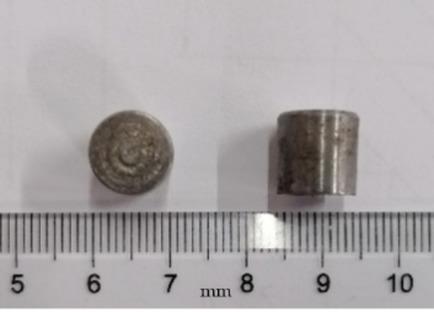当前位置:
X-MOL 学术
›
Propellants Explos. Pyrotech.
›
论文详情
Our official English website, www.x-mol.net, welcomes your feedback! (Note: you will need to create a separate account there.)
Study on Shock‐Induced Chemical Energy Release Behavior of Al/W/PTFE Reactive Material with Mechanical‐Thermal‐Chemical Coupling SPH Approach
Propellants, Explosives, Pyrotechnics ( IF 1.8 ) Pub Date : 2020-10-21 , DOI: 10.1002/prep.202000152 Kerong Ren 1 , Jin Chen 2 , Hua Qing 1 , Rong Chen 3 , Peng Chen 2 , Yuliang Lin 3 , Baoyue Guo 3
Propellants, Explosives, Pyrotechnics ( IF 1.8 ) Pub Date : 2020-10-21 , DOI: 10.1002/prep.202000152 Kerong Ren 1 , Jin Chen 2 , Hua Qing 1 , Rong Chen 3 , Peng Chen 2 , Yuliang Lin 3 , Baoyue Guo 3
Affiliation

|
Reactive materials (RMs) are usually prepared from metal/non‐metal mixed powders through hot processing. RMs are widely used in warheads since they are inert under common conditions but release massive amounts of energy in chemical reactions induced by impact loading. However, the shock‐induced chemical energy release during impact has a complicated mechanism and needs to be further explored. This work investigated the shock‐induced chemical energy release behavior of the Al/W/PTFE RM. The experimental results show that the energy release efficiency of RM in direct ballistic tests increases with increasing impact velocity (v), and the extent of chemical reaction (y) can reach ∼0.8 at v=1250 m s−1. Meanwhile, we propose a new numerical simulation approach based on the LS‐DYNA software, combining the user‐defined equation of state considering the chemical reactions and the smoothed particle hydrodynamics (SPH) method. This approach can describe the ultra‐fast chemical reaction and crushing behavior of Al/W/PTFE RM during the impact process, taking into account the mechanical‐thermal‐chemical coupling effect. The relative errors of y between the numerical simulations and the experiments are below 25 %. Moreover, the simulation results also provide many details about the ultra‐fast chemical reactions. As v increases, the values of y and the maximum chemical reaction rate (dy/dtmax) also increase from 0.134 and 0.017 μs−1 at v=700 m s−1 to 0.882 and 0.181 μs−1 at v=1300 m s−1, respectively.
中文翻译:

机械/热化学耦合SPH方法研究Al / W / PTFE活性材料的冲击诱导化学能释放行为
反应性材料(RMs)通常是由金属/非金属混合粉末通过热加工制成的。RMs在弹头中被广泛使用,因为它们在普通条件下是惰性的,但会在冲击载荷引起的化学反应中释放大量能量。但是,冲击过程中由冲击诱发的化学能释放具有复杂的机理,需要进一步探索。这项工作研究了Al / W / PTFE RM的冲击诱导化学能释放行为。实验结果表明,在直接弹道试验中,RM的能量释放效率随冲击速度(v)的增加而增加,化学反应的程度(y)在v = 1250 m s -1时可达到〜0.8。同时,我们提出了一种基于LS‐DYNA软件的新型数值模拟方法,该方法结合了用户定义的考虑化学反应的状态方程和平滑粒子流体动力学(SPH)方法。考虑到机械-热化学耦合效应,该方法可以描述冲击过程中Al / W / PTFE RM的超快速化学反应和破碎行为。数值模拟与实验之间的y相对误差低于25%。此外,仿真结果还提供了有关超快速化学反应的许多细节。随着v的增加,y的值和最大化学反应速率(d y / d t max)也从0.134 0.017微秒增加-1在v = 700米每秒-1至0.882和0.181微秒-1在v 1300 =米每秒-1分别。
更新日期:2020-12-07
中文翻译:

机械/热化学耦合SPH方法研究Al / W / PTFE活性材料的冲击诱导化学能释放行为
反应性材料(RMs)通常是由金属/非金属混合粉末通过热加工制成的。RMs在弹头中被广泛使用,因为它们在普通条件下是惰性的,但会在冲击载荷引起的化学反应中释放大量能量。但是,冲击过程中由冲击诱发的化学能释放具有复杂的机理,需要进一步探索。这项工作研究了Al / W / PTFE RM的冲击诱导化学能释放行为。实验结果表明,在直接弹道试验中,RM的能量释放效率随冲击速度(v)的增加而增加,化学反应的程度(y)在v = 1250 m s -1时可达到〜0.8。同时,我们提出了一种基于LS‐DYNA软件的新型数值模拟方法,该方法结合了用户定义的考虑化学反应的状态方程和平滑粒子流体动力学(SPH)方法。考虑到机械-热化学耦合效应,该方法可以描述冲击过程中Al / W / PTFE RM的超快速化学反应和破碎行为。数值模拟与实验之间的y相对误差低于25%。此外,仿真结果还提供了有关超快速化学反应的许多细节。随着v的增加,y的值和最大化学反应速率(d y / d t max)也从0.134 0.017微秒增加-1在v = 700米每秒-1至0.882和0.181微秒-1在v 1300 =米每秒-1分别。



























 京公网安备 11010802027423号
京公网安备 11010802027423号